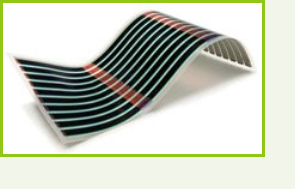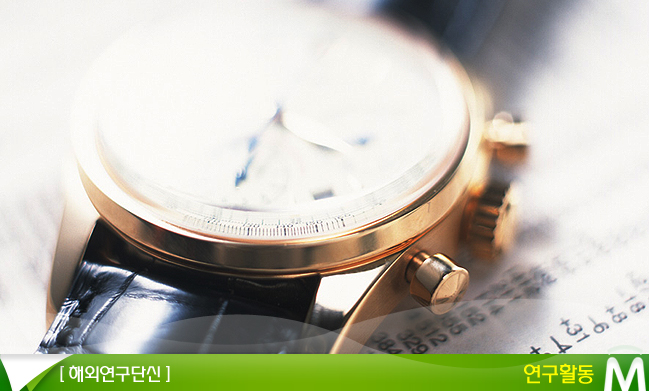 |
KIMS 해외단신 35호 (2010.07.29)
 박막태양전지의 돌파구: 인듐/갈륨 퍼즐에 대한 새로운 시각 박막태양전지의 돌파구: 인듐/갈륨 퍼즐에 대한 새로운 시각
( Breakthrough in Thin-Film Solar Cells
: New Insights Into the Indium/gallium Puzzle
)
 Johannes Gutenberg University Mainz(JGU, 독일 마인츠)는 효율적인 박막 태양전지를 개발하는 연구에 큰 돌파구를 제시했다. 소위 인듐/갈륨 퍼즐이라 불리는 것을 연구하기 위해 제작된 컴퓨터 시뮬레이션이 CIGS 박막 태양 전지의 효율을 높이는 새로운 방향을 제시했다. 이론적으로는 30%까지 효율성을 높일 수 있지만 기존의 기술은 20%까지 달성한 상황이다.
박막 태양전지는 점차적으로 태양전지 시장의 많은 폭을 차지하고 있다. 그 두께가 수 마이크로미터밖에 되지 않기 때문에 재료와 제조에 드는 비용을 줄일 수 있다. 현재의 최대 효율인 20%는 구리, 인듐, 갈륨, 셀렌 및 황으로 구성된 박막을 이용해 태양광을 흡수하는 CIGS 박막 태양전지가 달성했다. 하지만 현재까지 달성된 효율성은 이론상으로 가능한 단계에 전혀 미치지 못한다.
Claudia Felser 교수가 이끄는 마인츠 대학의 연구팀은 화학적 구성이 Cu(In,Ga)(Se,S)2인 CIGS의 특성을 연구하기 위해 컴퓨터 시뮬레이션을 사용하고 있다. 이번 연구는 Federal German Ministry for the Environment, Nature Conservation, and Nuclear Safety (BMU)의 자금으로 이루어진 comCIGS 프로젝트의 일부이다. IBM 마인츠와 Schott AG가 CIGS 태양전지를 최적화 하기위한 프로젝트를 수행중인 Johannes Gutenberg University Mainz, Helmholtz Center Berlin for Materials and Energy 및 Jena University와 공동연구를 추진하고있다. 연구자들은 몇 년 간 과학자들을 힘들게 하고 있는 인듐/갈륨 퍼즐에 특히 중점을 맞추고 있다. 지금까지 인듐:갈륨의 최적 비율은 30:70이 되어야 한다고 계산을 바탕으로 상정되어 왔지만 실제로 최대 효율은 정확히 그 반대인 70:30일 때 얻어졌다.
IBM 마인츠의 지원으로 Felser 교수팀 Christian Ludwig은 밀도 범함수 계산(density functional calculations)과 몬테카를로 시뮬레이션(Monte Carlo simulations)을 병합한 새로운 계산을 수행했다. “밀도 범함수 계산을 통해 양자역학적 관점에서 지역 구조의 에너지를 평가 할 수 있다. 그 결과는 몬테카를로 시뮬레이션을 통해 광범위한 온도 범위에서 효과를 결정짓는데 사용될 수 있다.”고 Felser 교수팀 이론그룹 그룹장인 Thomas Gruhn박사가 그 방법을 설명했다. Christian Ludwig는 연구를 위해 Shared University Research(SUR) 과학상의 일환으로 IBM이 Mainz University에 기증한 메인프레임을 사용할 수 있다.
 재료의 균질성을 높이는 고온 생산 재료의 균질성을 높이는 고온 생산
시뮬레이션을 통해 CIGS 소재에 인듐과 갈륨 핵이 균일하게 배분되어있지 않다는 사실이 알려졌다. 적당한 온도가 되기 직전에 인듐과 갈륨이 완전히 분리되는 단계가 있다. 소재가 이러한 적당 온도보다 더 뜨거워지면 다른 사이즈의 인듐과 갈륨 핵 클러스터가 생성 된다. 온도가 높아지면 높아질수록 소재는 더욱 균일하게 된다. 실험을 통해 갈륨의 양이 많은 CIGS는 인듐이 많은 CIGS에 비해 균질하지 못하다는 사실이 명확해졌다. 이러한 균질성의 부족으로 갈륨의 양이 많은 재료는 광전자적 특성이 약하고, 그로 인해 갈륨의 양이 풍부한 CIGS 연료의 저효율성을 유발한다는 사실이 처음으로 설명되었다. 계산을 통해 CIGS 태양전지를 생산하는 최적의 방법 또한 알 수 있다. 고온에서 생성될 경우 재료의 균일성은 현저히 우수하다. 우수한 균일성을 유지하기 위해서는 재료를 충분히 빠른 속도로 냉각시켜야 한다.
태양전지 기판으로 사용되는 유리의 제한적인 열 저항력이 공정온도를 제약하고 있었지만 이 부분에서도 최근 돌파구가 만들어졌다. Schott AG는 공정 온도가 600°C이상으로 상승될 수 있는 특수 유리를 개발했다. 이 공정으로 개발된 전지는 비교적 더 균등해 더욱 효율적으로 전지를 생산할 수 있게 되었다. comCIGS 프로젝트 연구원들은 이미 다음 단계를 생각하고 있다. “우리는 현재 효율성면에서 기존의 전지를 능가하는 큰 포맷의 태양전지를 연구하고 있다. 연방정부 지원금인 comCIGS 프로젝트의 일환으로 수행되고 있는 마인츠 과학자들의 연구는 Physical Review Letters 최신 저널에 게재되어 있다.
(상기의 기사는 Universitaet Mainz가 제공한 자료를 바탕으로 ScienceDaily의 편집과 각색을 통해 재구성 된 것입니다.)
 Journal Reference:
1. Journal Reference:
1. Christian Ludwig, Thomas Gruhn, Claudia Felser, Tanja Schilling, Johannes Windeln, Peter Kratzer. Indium-Gallium Segregation in CuIn_{x}Ga_{1-x}Se_{2}: An Ab Initio%u2013Based Monte Carlo Study. Physical Review Letters, 2010; 105 (2): 025702 DOI: 10.1103/PhysRevLett.105.025702
http://www.sciencedaily.com/releases/2010/07/100719083044.htm
|
원문
Scientists at Johannes Gutenberg University Mainz (JGU) in Mainz have made a major breakthrough in their search for more efficient thin-film solar cells. Computer simulations designed to investigate the so-called indium/gallium puzzle have highlighted a new way of increasing the efficiency of CIGS thin-film solar cells. Researchers to date have achieved only about 20% efficiency with CIGS cells although efficiency levels of 30% are theoretically possible.
Thin-film solar cells are gaining an ever increasing proportion of the solar cell market. As they are only a few micrometers thick, they offer savings on material and manufacturing costs. Currently, the highest level of efficiency of about 20% is achieved by CIGS thin-film solar cells, which absorb the sunlight through a thin layer made of copper, indium, gallium, selenium, and sulphur. However, the levels of efficiency achieved to date are nowhere near the levels theoretically possible.
The research team at Mainz University headed by Professor Dr Claudia Felser is using computer simulations to investigate the characteristics of CIGS, whose chemical formula is Cu(In,Ga)(Se,S)2. This research forms part of the comCIGS project funded by the Federal German Ministry for the Environment, Nature Conservation, and Nuclear Safety (BMU). IBM Mainz and Schott AG are collaborating with the Johannes Gutenberg University Mainz, the Helmholtz Center Berlin for Materials and Energy and Jena University in the project that is targeted at finding ways of optimizing CIGS solar cells. The researchers focused in particular on the indium/gallium puzzle that has been baffling scientists for years: Although it has been postulated on the basis of calculations that the optimal indium:gallium ratio should be 30:70, in practice, the maximum efficiency level has been achieved with the exactly inverse ratio of 70:30.
With the support of IBM Mainz, Christian Ludwig of Professor Felser's team undertook new calculations with the help of a hybrid method in which he used a combination of density functional calculations and Monte Carlo simulations. "Density functional calculations make it possible to assess the energies of local structures from the quantum mechanical point of view. The results can be used to determine temperature effects over wide length scale ranges with the help of Monte-Carlo simulations," Dr Thomas Gruhn, head of the theory group in Professor Felser's team, explains the methods used. Christian Ludwig is able to use a mainframe for his investigations that was recently donated to Mainz University by IBM as part of a Shared University Research (SUR) science award.
 Production at high temperatures promotes homogeneity of the material Production at high temperatures promotes homogeneity of the material
With the aid of the simulations, it was discovered that the indium and gallium atoms are not distributed evenly in the CIGS material. There is a phase that occurs at just below normal room temperature in which the indium and gallium are completely separate. If the material is heated to above this demixing temperature, differently sized clusters of indium and gallium atoms do form. The higher the temperature, the more homogeneous the material becomes. It has now become apparent that gallium-rich CIGS is always less homogeneous than indium-rich CIGS. Because of this lack of homogeneity, the optoelectronic properties of the gallium-rich material are poorer, resulting in the low efficiency levels of gallium-rich CIGS cells -- an effect that has now been explained for the first time. The calculations also provide a concrete indication of the best way to manufacture CIGS solar cells. If it is produced at higher temperatures, the material is significantly more homogeneous. To retain the desired homogeneity, the material then needs to be cooled down sufficiently rapidly.
In practice, it was the limited heat resistance of the glass used as a substrate for solar cells that has always restricted process temperatures, but a significant breakthrough has also recently been made here. Schott AG has developed a special glass with which the process temperature can be increased to well above 600°C. The cells that result from this process are considerably more homogeneous, meaning that the production of cells with a much greater efficiency level has become possible. But the comCIGS project researchers are already thinking ahead of this. "We are currently working on large-format solar cells which should outperform conventional cells in terms of efficiency," states Gruhn. "The prospects look promising."
The work of the scientists in Mainz, conducted as part of the federal government-funded comCIGS project, has been published in the latest edition of the journal Physical Review Letters.
(The above story is reprinted, with editorial adaptations by ScienceDaily staff, from materials provided by Universitaet Mainz.)
 Journal Reference: Journal Reference:
1. Christian Ludwig, Thomas Gruhn, Claudia Felser, Tanja Schilling, Johannes Windeln, Peter Kratzer. Indium-Gallium Segregation in CuIn_{x}Ga_{1-x}Se_{2}: An Ab Initio%u2013Based Monte Carlo Study. Physical Review Letters, 2010; 105 (2): 025702 DOI: 10.1103/PhysRevLett.105.025702
http://www.sciencedaily.com/releases/2010/07/100719083044.htm |
| |
출처)
ScienceDaily 2010년 7월 20일자 기사 발췌, 번역
문의) 재료연구소 정책홍보실 이수아
(leesooa@kims.re.kr) |
|
 |
|
|
